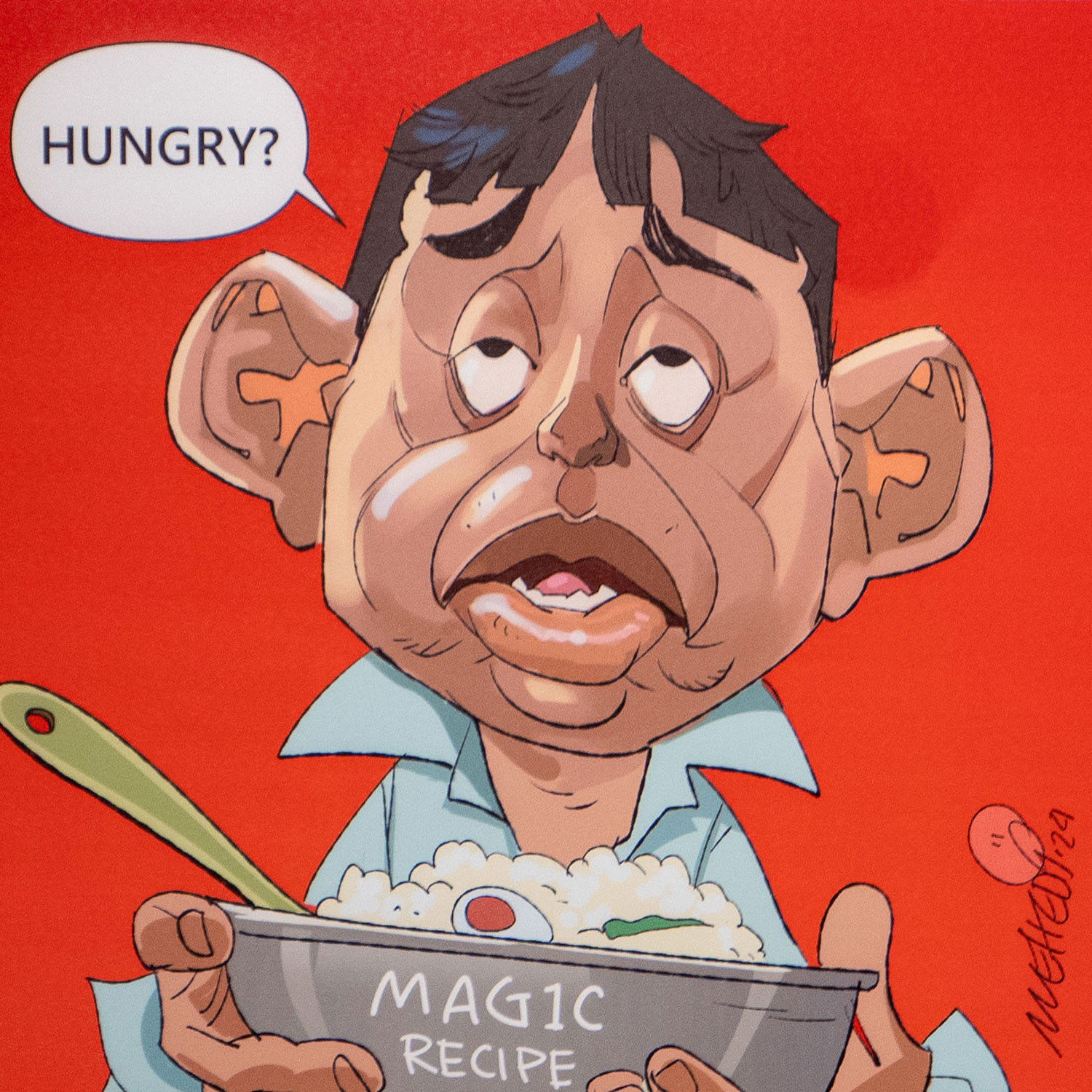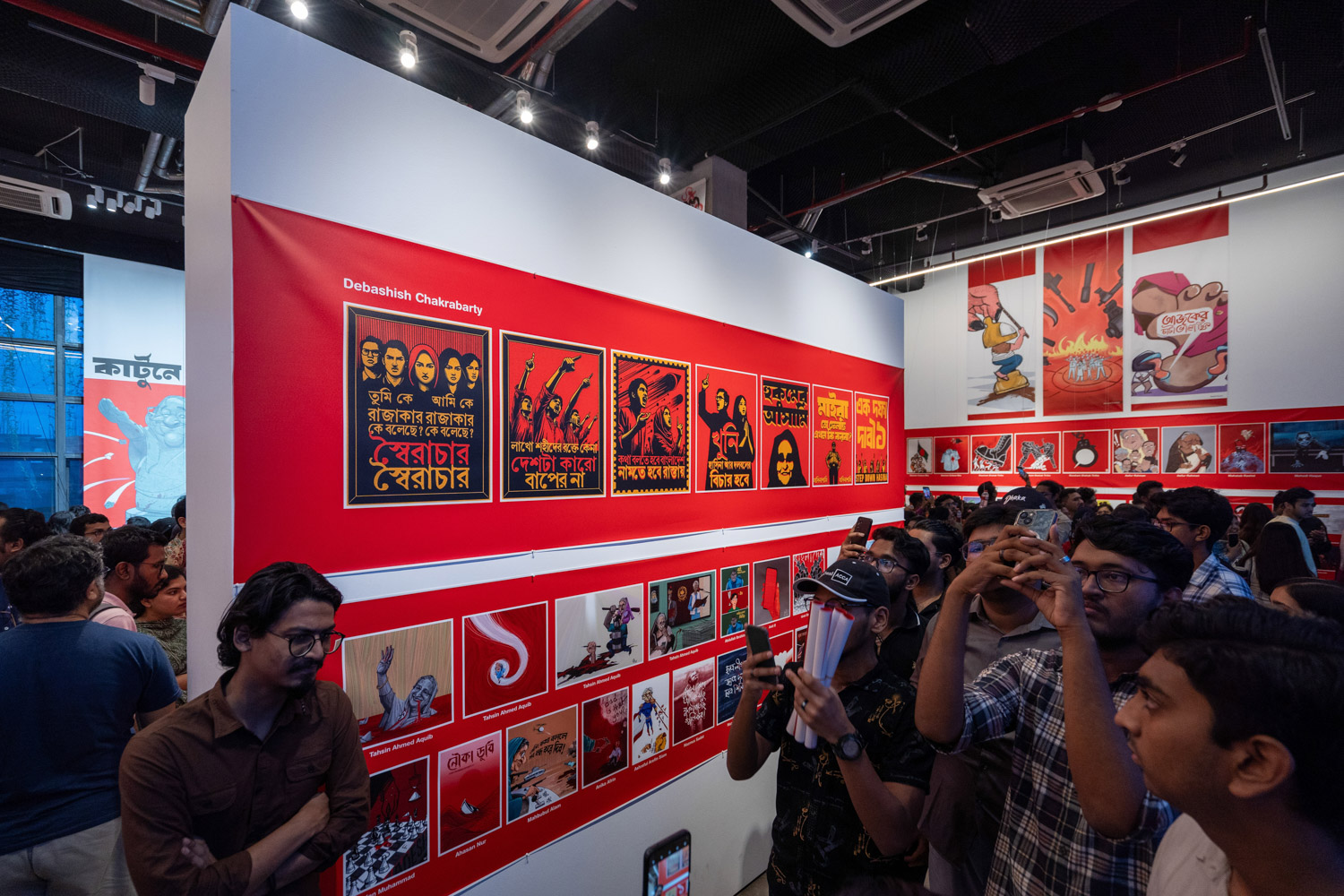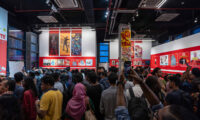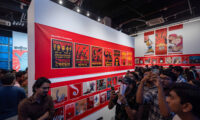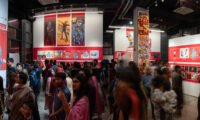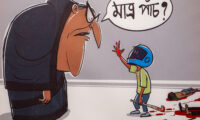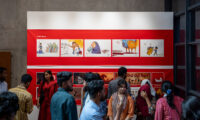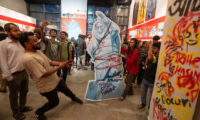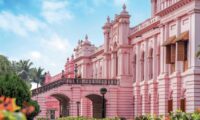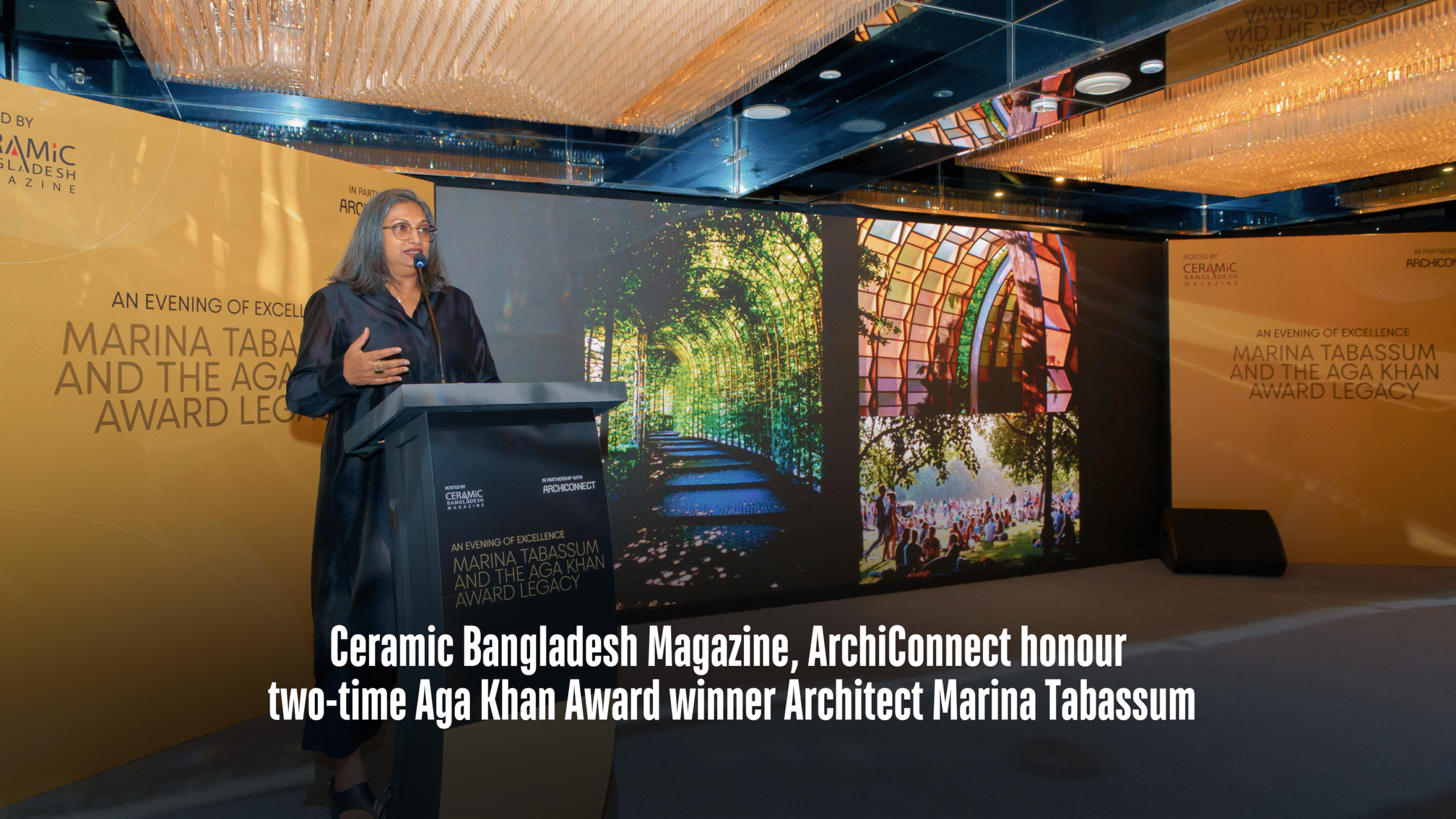
Ceramic Bangladesh Magazine, ArchiConnect honour two-time Aga Khan Award winner Architect Marina Tabassum
Ceramic Bangladesh Magazine, a publication of the Ceramic Manufacturers and Exporters Association (BCMEA), and ArchiConnect, a buildtech platform, honoured Architect Marina Tabassum on Saturday evening, November 8, 2025, Bangladesh’s only two-time winner of the Aga Khan Award for Architecture—one of the most prestigious awards in the world for architects. At the programme, held at the Renaissance Dhaka Gulshan Hotel, the globally acclaimed architect delivered a keynote speech titled “Between Erosion and Emergence”, highlighting different aspects of the projects that brought her international recognition. Before her keynote, Architect Jalal Ahmed, founder and CEO of ArchiConnect, explained why Marina Tabassum’s achievement should be celebrated and how significant it is. He said the Aga Khan Award for Architecture is considered the “Oscar for Architects,” and winning it twice is a phenomenal success for any architect in the world. Later, Marina presented details of her various projects worldwide. Bait Ur Rouf Mosque, completed in 2012 on the outskirts of Dhaka, was the project that earned her the prestigious Aga Khan Award for Architecture in 2016. “Built with locally sourced brick and devoid of traditional Islamic iconography, it offers a contemplative space where worshippers are bathed in natural light,” she said at the event. “The structure is not just a place of prayer—it’s a refuge for a dense, underserved neighbourhood.” She also shed light on one of her most celebrated recent projects, Khudi Bari, a modular, lightweight shelter designed for ultra-low-income populations. The structure, made of bamboo and corrugated metal, can be assembled quickly and relocated as needed. Earlier, Chief Adviser Professor Muhammad Yunus, in a public congratulatory message, echoed this sentiment: “We fondly recall your first Aga Khan Award in 2016 for the Bait Ur Rouf Mosque in Dhaka, a milestone that celebrated the timeless values of spirituality, community, and simplicity in architecture.” “That recognition marked the rise of a Bangladeshi voice of global significance, and your latest achievement further strengthens that legacy.” In 2025, Khudi Bari earned Tabassum her second Aga Khan Award for Architecture, making her the only Bangladeshi architect to win the honour twice. That same year, she was commissioned to design the Serpentine Pavilion in London—an international recognition of her ability to merge local wisdom with global relevance. Later, at the day, an engaging panel discussion was organised on “Marina Tabassum and the Aga Khan Award Legacy”. The session was moderated by Architect Mahmudul Anwar Riyaad, principal designer and director of DWM4 Architects. Distinguished panelists included Architect Professor Fuad Hassan Mallick, dean of the School of Architecture and Design (SoAD) at BRAC University; Architect Professor Zainab Faruqui Ali, chairperson of the Department of Architecture at BRAC University; and Architect Nahas Ahmed Khalil, principal designer at ARC Architectural Consultants. The event concluded with closing remarks by Moynul Islam, president of BCMEA. “We always look forward to creative minds like architects and the brilliance of Architect Marina Tabassum deserves to be celebrated.” Following the panel discussion, mementos were presented to the distinguished panelists and to Architect Moushumi Ahmed, the gracious host of the evening. The honorees—Architect Marina Tabassum, Architect Jalal Ahmed, and Moynul Islam, President of BCMEA—received exquisite woodprint artworks created by renowned artist Professor Anisuzzaman Anis of the Department of Printmaking, Faculty of Fine Art, University of Dhaka Written by CBM Desk
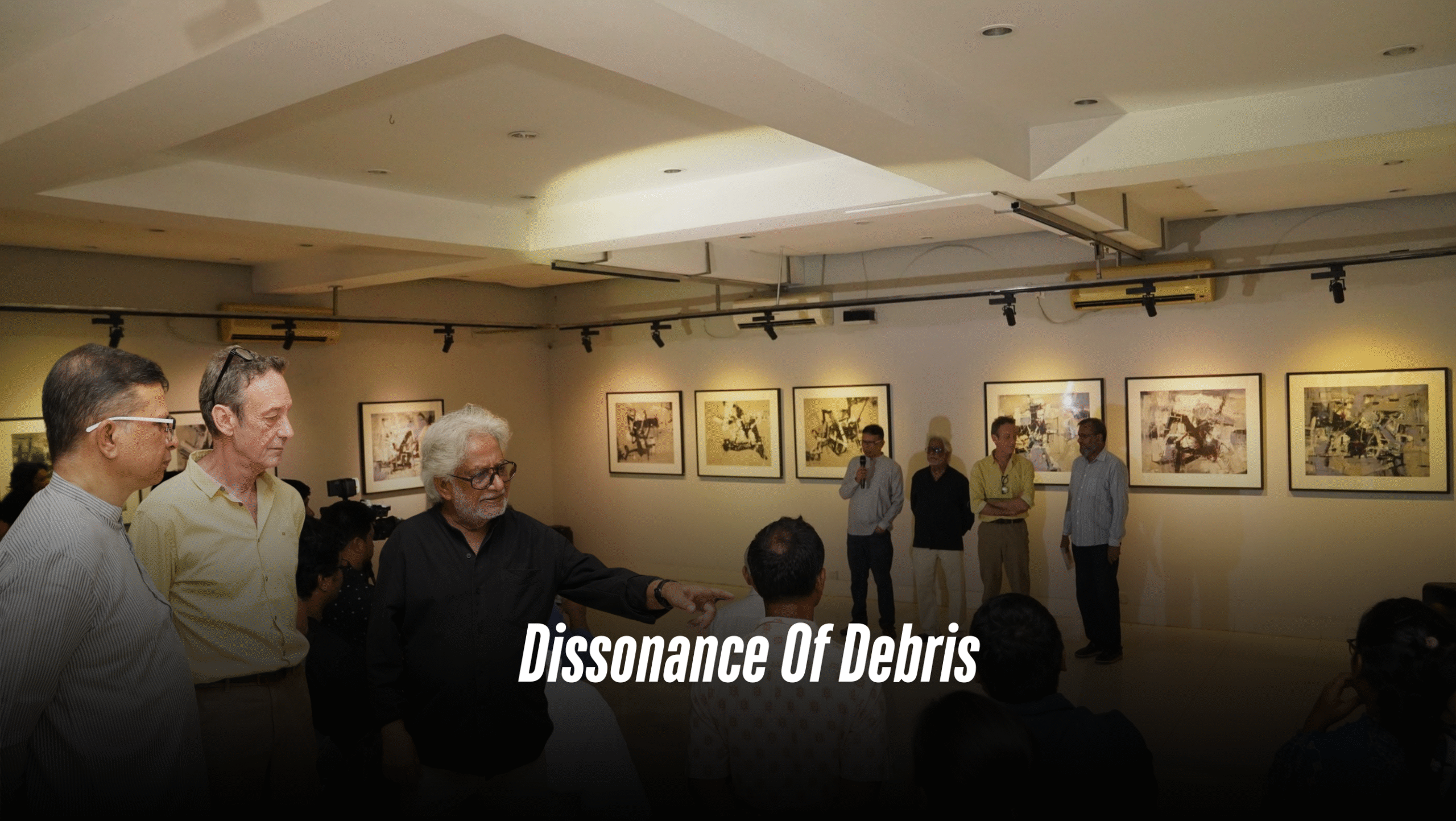
Dissonance Of Debris
From May 17th to 31st, the solo painting exhibition titled “Debris” by Kazi Salahuddin Ahmed adorned the walls of La Galerie, Alliance Française de Dhaka, Dhanmondi. The two-week-long, thought-provoking exhibition featured nearly 30 works on board paper, providing spectators with a glimpse into the artist’s most recent studies. Remembering is a kind of rebellion in Kazi Salahuddin Ahmed’s universe. His solo exhibition, “Debris,” was an uncompromising documentation of human vulnerability. The artist’s recollections of Bangladesh’s 1971 Liberation War seep into modern tragedies—Gaza’s annihilation, the Rohingya exodus, and Kashmir’s stifled cries. The paintings didn’t merely show ruins; they also resurrected spirits. Ahmed’s life had several eras of turmoil. Born within a world transformed by partition and war, his early work in the 1980s was abstract, but the twenty-first century tightened his emphasis. The song “Debris” captures this progression. Each piece is a palimpsest, with layers of pigment representing the strata of history, where erasure and evidence fight silently. Ahmed’s use of board paper as canvas makes a statement in and of itself. Board paper repels, as opposed to ordinary canvas, which absorbs, forcing the artist to handle surface tension. The resulting sculptures have a temporary quality, as if they would disintegrate like the makeshift shelters in Cox’s Bazar’s refugee camps. Though anchored in Bangladeshi stories, “Debris” speaks to a lexicon of global migration. The exhibition’s centerpiece, “Babel Fragment” (2024), depicts the mythological tower as a jagged silhouette against a sulfurous hue. Its shattered planes evoke both bombed-out Aleppo and the decaying tenements of Old Dhaka. Ahmed, who has flown from Paris to Islamabad, appears to imply that rubbish knows no boundaries. In “Eclipse of Return” (2024), a skeletal stairway rises into the emptiness, its steps fractured like vertebrae. Nearby, “Archive of Dust” displays a child’s sneaker half-buried in a thick texture that mimics charred dirt “The utter erasure of Gaza, which was once full of life; the ongoing miseries of people in Kashmir; or the hopelessness faced by displaced Rohingyas attempting to make a living in camps in Chattogram—all of this jostles the mind as one attempts to ponder the future of the human race. Furthermore, it is difficult to leave behind the legacy of Bangladesh’s repeated failures to shape a future. The people’s desire for political stability has always been a never-fulfilled dream in our country. The demise of the authoritarian dictatorship has undoubtedly allowed everyone to focus on a future beyond the current system, but it appears that things are still breaking apart, leaving us with only emotional rubble,” observed famous art critic Mustafa Zaman. The intimacy of “Debris” sets it apart from other forms of protest art. In “Letters Unsent,” bits of Urdu and Bangla letters emerge behind layers of gray, like voices muted by time. The piece is similar to Ahmed’s 2018 series on refugee diaries, but the language is virtually illegible—a metaphor for history’s selective memories. Written By Shahbaz Nahian

Rabiul Hussain in Architectural Narratives
On February 28, 2025 Bangladesh Institute of Architects (IAB) and the Bangladesh Liberation War Museum organized a day-long program to tribute architect Rabiul Hussain through visiting 3 of his projects- Bangladesh Agricultural Research Council (BARC), Jalladkhana Killing Ground and Jahangirnagar University. and taking a vow to protect the diversified works of the architect. Architect Rabiul Hussain (January 31, 1943 – November 26, 2019) was a prominent Bangladeshi architect, poet, art critic, short story writer, essayist, and cultural activist. A person of multifaceted talent, honored by the Government of Bangladesh with the Ekushey Padak for his contributions to language and literature in 2018, received the Bangla Academy Literary Award for his contributions to poetry in 2009, and the Bangladesh Institute of Architects (IAB) awarded him the Gold Medal for his outstanding contribution to architecture in 2016. He served four times as the President of the Bangladesh Institute of Architects, Vice-Chairman of the Architects Regional Council of Asia (ARCASIA), Vice-President of the Commonwealth Association of Architects, and President of the South Asian Association for Regional Cooperation of Architects. In addition, he was a trustee of the Liberation War Museum, an executive member of the 1971 Ghatok Dalal Nirmul Committee (Committee for Elimination of Martyrs’ Assassination), and made significant contributions to the preservation of the memories of the Independent War of Bangladesh. Although he was born in the village of Ratidanga in Shailkupa Upazila, Jhenaidah District, he completed his secondary and higher secondary education in Kushtia District. Later, in 1968, he earned his Bachelor degree in architecture from the then East Pakistan University of Engineering (now Bangladesh University of Engineering and Technology). After obtaining the graduation, he began his professional career as an architect working with architect Mazharul Islam and later joined Shahidullah Associates. Alongside his architectural practice, he also maintained a strong passion for writing. Throughout his career, he served as a life member of the Bangla Academy, and was involved in various organizations, including the Central Kachi-Kachhar Mela (a children’s and youth organization), the National Poetry Council, the Bangabandhu Sheikh Mujibur Rahman Memorial Museum, the International Film Critic Association of Bangladesh, and the Bangladesh Institute of Architects. Notable buildings designed by him include the Jalladkhana(Execution House), the Bangladesh Agricultural Research Council building, the entrance gate of Dhaka University, the Liberation and Independence Arch, the Jahangirnagar University gate, the Bhashani Hall, the Bangabandhu Hall, the Sheikh Hasina Hall, the Khaleda Zia Hall, the Wazed Mia Science Complex, the auditorium and academic building complex of Chittagong University, and alongside architect Mazharul Islam, the Bangladesh Agricultural Research Institute in Gazipur, Haji Mohammad Danesh Science and Technology University in Dinajpur, and polytechnic institutes in Chittagong and Khulna, among others. Bangladesh Agricultural Research Council (BARC) The Bangladesh Agricultural Research Council (BARC) was established in 1973 with the aim of conducting agricultural research and coordinating various related institutions in Bangladesh. Almost a decade after its founding, in 1982, architect Rabiul Hussain designed its current building. The design process, which began in 1978, spanned nearly four years. In a remarkable way, he crafted a unique architectural design using red brick masonry that harmonized with Bangladesh’s climate, nature, and way of life. This building is a symbol of post-independence architecture, reflecting a search for an architectural style; that is free from the burden of colonization in a newly liberated land. Each detail of the building echoes the same vision. The regional architectural influence of Maestro Mazharul Islam, the pioneer of Bangladesh’s regional architecture, is evident in the design, which he was fortunate to experience starting from his third year of architectural education. The building, located on a site shaped like the letter ‘L’ in the English alphabet, is easily noticeable among surrounding roads and structures. It stands at the junction of Airport Road and Khamar Bari Road, near Farmgate and Bijoy Sarani. The design symbolizes various aspects of aesthetic gravity, marking an early effort in the evolution of post-independence Bangladeshi architecture and the search for a Bengali “identity” in the country’s-built environment. The location of the building, near the capital’s main international airport at Tejgaon, limited the building’s height to four floors. The rectangular building, measuring 223 feet in length and 63 feet in width, has a total built-up area of 32,700 square feet. It is aligned along the east-west axis and is equipped with optimal provisions for cross-ventilation and prevailing south winds. The three-story building is vertically divided into three functional zones. The first floor is allocated for administrative offices; the second floor houses the executive branch. The third floor features a 7,500-square-foot conference room with seating for 280 people at its center, along with a 1,350-square-foot library and a meeting room. The first and second floors are organized along a double-loaded corridor, with two staircases at the eastern and western ends of the building. In harmony with local traditions, the roof was projected to protect the building from torrential rain and scorching sun. The BARC building essentially consists of two parts: one is the brick-clad inner shell that spans the main area, while the additional levels moderate the harsh tropical sun and protect the building during the monsoon season. Architect Mazharul Islam’s office- Vastukalabid was a key influence in experimenting with such a critical combination of climate consideration and modernist aesthetics along with that of brick mason for architect Rabiul Hussain and many young architects in the early 1970s. To give an example, his designs, including the National Institute of Public Administration (1964), encouraged a generation of architects to explore “critical regionalism” through a lens that considered climatic aspects in the visual language of architecture. Since stone is rare and fired bricks can be produced in abundance from local clay, architects saw bricks as an unprecedented symbolic representation of the delta and its culture. Representing the soil of the riverine country, bricks were the purest or most organic building material believed by the Bangladeshi architects. The “poetry” of bricks is hard to miss in the concept and construction of the BARC headquarters building. Also, the influence of
